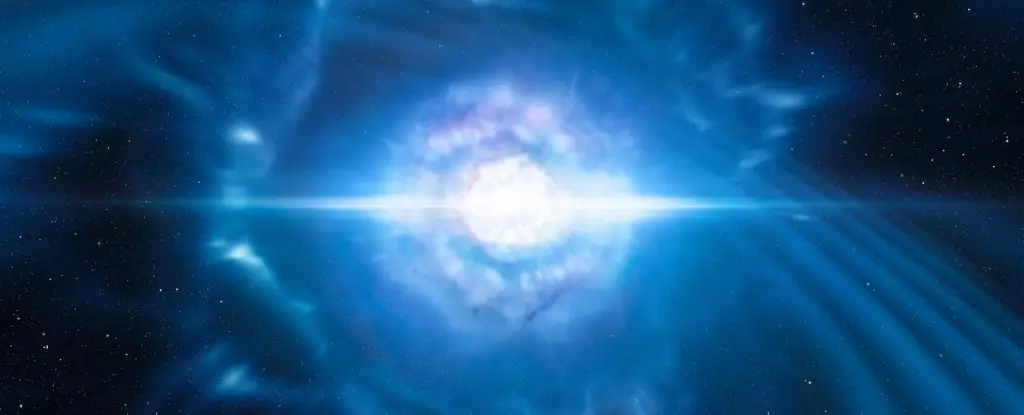In August 2017, astronomers were graced with an extraordinary spectacle that would further complement our understanding of the cosmos: the collision of two neutron stars. This landmark event, observed worldwide by various telescopes, was marked by the subsequent formation of a black hole and a kilonova explosion, named AT2017gfo. The unique features of this cosmic event have not only captivated the scientific community but also generated a trove of data for analysis. Scientists, especially those such as astrophysicist Albert Sneppen from the Niels Bohr Institute, have dedicated their efforts to creating a comprehensive narrative of the aftermath of this collision and what it entails for our grasp of the universe’s elemental origins.
The significance of AT2017gfo extends far beyond its immediate spectacle; it offers a vista into the transformative processes that govern astronomical phenomena. As the neutron stars spiraled into one another, the gravitational waves produced acted as a beacon, alerting a coalition of telescopes spread across globe to hone in on this cosmic clash. However, tracking such a swiftly evolving event proved demanding, given the complexities of monitoring from differing angles due to Earth’s rotation. As Sneppen elucidates, no single telescope could comprehensively capture the ongoing metamorphosis of the explosion—rather, it required an innovative amalgamation of observations sourced from various geographical locations including Australia, South Africa, and the Hubble Space Telescope.
This strategic collaboration allowed researchers to compile data, revealing a highly detailed hour-by-hour evolution of the kilonova. The integrative approach established that the whole is indeed greater than the sum of its parts—a novel insight into how collaborative data analysis can enhance our understanding of astrophysical events. Crucially, it also highlights the limitations of traditional observational methods and the necessity for global teamwork in the pursuit of cosmic knowledge.
One pivotal aspect of the observations surrounding AT2017gfo was the revelation of heavy element synthesis. While stellar cores are known to create elements up to iron through nuclear fusion processes, the generation of heavier elements requires cataclysmic events, such as supernovae or, as revealed in this case, kilonovae. Mining the luminous signatures emitted during the kilonova’s explosion, astronomers identified strontium among the heavy elements produced.
Exploring further into the intricate data sets, Sneppen’s research team made strides in documenting the synthesis of r-process elements, which are critical to understanding the evolutionary patterns of atomic structures. During the kilonova event, the initial explosion unleashed an environment of extreme heat—billions of degrees—akin to that of the universe during the Big Bang. In this fleeting yet potent phase, elementary particles interacted frantically, eventually coalescing into atoms as the environment cooled, mirroring a fundamental process from the early universe known as the Epoch of Recombination.
The connection between the kilonova din and the early universe symbolizes an exciting chapter in astrophysics. Approximately 380,000 years post-Big Bang, the universe cooled sufficiently for primordial plasma to transition into hydrogen and helium atoms, enabling light to pervade the cosmos unimpeded. This epoch, marked by the ‘recombination’ of particles, bears a striking resemblance to the processes observed in AT2017gfo.
Thus, the kilonova explosion presents itself as a compact laboratory through which scientists can glean insights into the universe’s primordial history. By capturing the moment when atomic nuclei and electrons united, researchers can measure the temperature of matter present and delve deep into the microphysics at play in this extraordinary explosion. As astrophysicist Rasmus Damgaard articulated, witnessing this process is akin to seeing a cosmic background radiation enveloping us, but with the added dimension of observing the birth of atomic structures.
The discoveries surrounding AT2017gfo extend our comprehension of not only neutron star collisions but also the astrophysical processes that underpin our universe. The study encapsulates the essence of collaborative scientific inquiry, reminding us that understanding the cosmos is a collective endeavor. The data gleaned from this kilonova explosion establishes that neutron star mergers serve as pivotal factories for heavy elements—an insight critical to comprehending the evolutionary narrative of our cosmos. As we continue to explore these phenomena, we remain on the precipice of uncovering more profound truths about the universe’s birth and transformation, one kilonova at a time.

